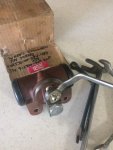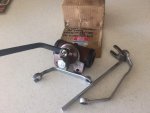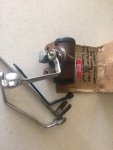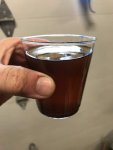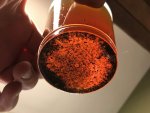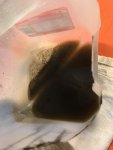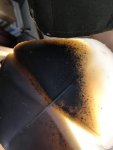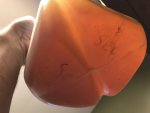Note I have intentionally been running my fuel filters longer than I think they should be, especially considering the alternative fuels I run constantly. I wanted to test to failure and replace them at first sign of trouble. It looks like I found that point.
Yesterday I went for a spin to meet a couple buddies for lunch and was running low on fuel and carrying a couple fuel cans (one 5 gallon of diesel and one 2 gallon of gas just in case) to continue thinning out the veg oil I’d been running over the Summer. I got about ½ way to my destination and in a bad spot (no shoulder to pull off) when she started to sputter a bit (note she normally purrs like a kitten) and have one of those massive bouncy unloaded rear events at the same time. RATS! I came to a safe place to pull off with a shoulder and a break in traffic and began to add the 5 gallons of diesel from this new fancy “safe” canister. RATS! I spilled all over, got it up my sleeve, spilled on my pants, all over the ground, etc. RATS! Those #$%^ “safety” “environmental” or WTF OVER POS cans are the worst! Thanks for ruining my pants whoever forced that stupidity on us… Anyway, with some more fuel in I got to where I was going but she still sputtered a bit.
On the way home she ran perfect with no issues. So then when I got home I thought I would drain the primary (NAPA 3405 | WIX33405 JATonka kit) before shutting it off. I backed off the drain and it was sticky with nothing coming out, so I kept on backing it out. This is one of those situations in a guy’s mind where he knows something is amiss, yet keeps going. Error in judgment alert! I kept backing it out waiting for a dribble and just kept going even though nothing was coming out. All the sudden the plug flow out and began spraying into this little cup that I planned to use to capture the crud and play show and tell with yall. Note this pic is from after all of this played out, yet shows why nothing came out at first.
Soooo, with a 5/16 inch or so diameter column of fuel|veg oil blend spraying down and the plug nowhere in sight, I went running for the fuel cutoff and power switch. With that off I ran back looking for the plug with a column of fuel still spraying on the ground… And then it starts to pour down rain… I find the plug and begin to thread it in with a nice flow of fuel dribbling down my arm and into my clean shirt and jacket… I managed to get the plug back in and cross-threaded it in the process. The plastic plug seems to have swollen due to exposure to my fuel blends.
I decided it was time to replace the primary fuel filter. I carry a spare set in the tool box just in case. Upon seeing the debris in the primary (see pics without SEC, see below), I decided it was time to replace the secondary filters also. Thanks to having the JATonka secondary kit also, it just took a few minutes. Looking back through my records I found:
5/5/13, 39,864 miles, 1,609 hours – replaced primary and secondary fuel filters
11/2/17, 46,279 miles, 1,828 hours – replaced primary and secondary fuel filters
View attachment 706821View attachment 706822View attachment 706823View attachment 706824View attachment 706827
The small cup is what I captured as the primary plug popped off and the milk jug is the dump from the primary filter. The pic of the milk jug bottom with SEC written on it is what came out of my secondary filters. It’s pretty clean, so it seems the primary has been doing a great job of catching the crud. The crud did not move when I waved a magnet by them and when feeling them the
hunks seem like rubber.
Any ideas on what this crud is?
I need to make it more of a habit of draining the primary periodically and probably should replace the filters more often. I took her for a spin again this morning, took on 17 gallons of #2 to continue thinning the veg oil, and she is purring like a kitten again.


